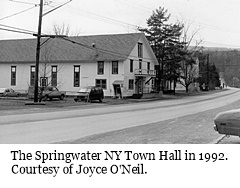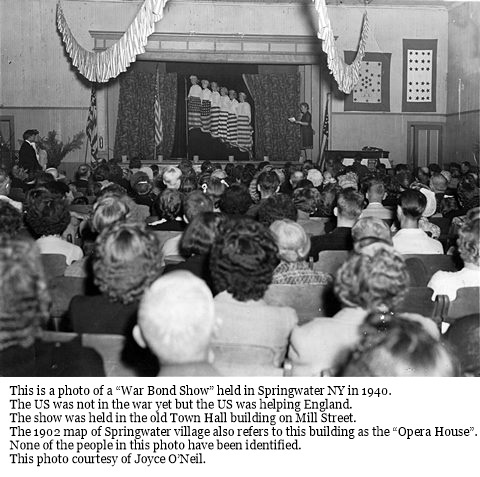
Welcome to Hemlock and Canadice Lakes!
Barns Businesses Cemeteries Churches Clinton & Sullivan Columns Communities Documents Events Time Line Fairs & Festivals Farm & Garden Hiking Homesteads Lake Cottages Lake Scenes Landscapes Library News Articles Old Maps Old Roads & Bridges Organizations People Photo Gallery Podcasts Railroad Reservoir Schools State Forest Veterans Videos
|
Organization - The Town Hall in Springwater NY |
|
|
The History of Springwater Town Hall By J. Reid Robinson - The Valley News 15 February 1968 |
||
|
The Springwater Town Hall as it appeared in 1992. The Springwater Town Hall was built in the year 1885 as noted by a sign displayed on the front of the building. It was built by a group of local men who formed a company as an investment to be used primarily for roller skating as well as for various other types of entertainment. It was given the name “Concert Hall.” At the time of its construction roller skating was a very popular form of recreation. A suitable hard maple floor was laid in the hall to make it best for that purpose. The stage across the south end had no curtain and was about one half as wide as it now is. It was wide enough, however, to seat “Hi” Wilson’s Cornet Band which played for the skaters. Frank Wilson, late of Springwater, played the alto horn in his father’s band. The skaters had much more floor space to use then since the town clerk’s office and rest rooms were not added until years later. The space now occupied by the American Legion room was originally built as a balcony to provide seating space for spectators who might wish to watch the skaters and listen to the music. It also provided seats for those who paid to watch skating races and other forms of entertainment. Springwater had at least, one better than average skater in the person of Dwight Norton, brother of Hugh Norton, who held the championship for speed skating of Livingston County about the years 1886 - 1889. Many races were held in the “Concert Hall” as it was at one time called. Occasionally, masquerade “Skates” were held with prizes offered for the most original and funniest costumes. I remember my father and my Aunt Phoebe masquerading as an Indian and a squaw at one such skating party. After the popularity for skating waned, a few years later, the town of Springwater purchased the building and site from Sheldon and Mabel Robinson on April 1st, 1911, that it might serve as a voting place for both districts. The boundary line separating the two election districts was moved so that it passed through the center of the hall in a northerly and southerly direction. This made it possible for all qualified voters to cast their ballots at the same place. After the town purchased the hall, which became known as the “Town Hall”, the former balcony was enclosed across the front. The room thus made was used by the G. A. R. as a meeting place. The outside door at the foot of the stairs, was built when the building was constructed. As the years passed, the hall provided a place for many and various activities; elections, medicine shows, home talent minstrels, Memorial Day exercises, school commencement programs, law suits, basketball games, raffles, conventions, actions, dances and flower shows. Perhaps one of the outstanding home talent musicals ever staged here was an operatta called “Queen Esther”, directed by a man named Butterfield, probably, about 1890. Some of the local cast were Charles Smith; played the part of the King, Mordecia, James Snyder, Hanons girl, Nellie Beers, Hammon’s wife, Jessie Howard. This operatta was staged at three different times. Other local talent, who at one time staged shows in the hall were George Sanger, Frank S. De Vere, and Hugh Norton. Norton was the most accomplished of the three. Silent motion pictures created a new need for a balcony. The partition across was removed in 1924 and a terraced floor was put down to provide seating space for the spectators. The door at the foot of the stairs was put in at this time. The town had a fire proof booth installed in which to operate the movie projector. The Springwater Amusement Company began showing silent motion pictures in 1920. Mr. Utise was the operator in 1924, a Mr. Goler had the shows in 1922. The hall rented for $5 to $6 per night price of admission was 25 cents. Nash operated the picture show for a year or so about 1925, then later in 1926 Clifford Foley was the operator. The “Old Time” movies flickered and were sometimes but shadows and they were silent. Since but one projector was used it was necessary when the picture stopped to put a slide on the projector which read “One Minute Please, Changing Film.” Other slides that flashed on the screen were, “Ladies, please remove your hats. Gentlemen please refrain from smoking.” The music was provided by a pianist who played accordilng to the tempo of the pictures. About 1934 or 1935, the terraced floor was removed and used to make a partition enclosing the room for two rows of seats. This arrangement was found to be contrary to insurance regulations so the partition was moved forward to the present position. The hall was re-roofed and the interior redecorated in 1927 by John Schultz at a cost of $1261.24 following a fire which did little damage. The town board began holding it’s meetings in the “Concert Hall” for the first time in 1885, where in the Concert Hall the town board met, is not definitely known. It is believed a small room was provided in the north east corner. Prior to this such meetings were held in the Alger Hotel. Since the town board purchased the Concert Hall in 1911 from Sheldon and Mabel Robinson (for $1050 and they also paid the Robinsons $75 for the furniture) the hall has had a few alterations and kept in fairly good repair. In 1911, the town board voted that $100 be expended to repair and furnish the town clerks office. The foundations were repaired in 1918, in 1919 the concrete steps in front of the hall were ordered constructed and a gas lighting system was installed in 1915 at a cost of $115 which was replaced by electric wiring in 1925 by John Schultz. The same year the interior of the hall was redecorated by Schultz for $150. In 1920, the first toilets were put in at a cost of $445.40, by Stephen Robinson. The first steps on the east side leading from the stage were built of wood in 1921, replaced by iron ones in 1963. The interior of the town hall was redecorated in October 1948, at a cost of $700. The interior was put in its present condition in 1963. That same year the hall was pushed to the west to it’s present vertical position. This was done before the interior was changed. A new roof was put on in 1964. In 1965 an overhead heating system was installed. The front entrance was rebuilt in 1965. The most recent change is the addition of the new rest rooms in 1967. Also the new concrete steps and landing were built in the summer of 1967. An observation post was built on top of the town hall in October 1942 which for a while was manned night and day. This was a World War II precaution designed to spot the appearance of unfamiliar planes. The present stage curtains in the town hall were renewed by Hugh Norton in 1931. The first stage curtain that I recall was a drop one with a large painted scene in the center with ads of the local businessmen forming wide borders around it. A new roof was put on the hall in 1927 by John Schultz following a fire in the hall. The hall was flooded in 1928.
|
||
|
Photos of the Springwater Town Hall |
|
1 |
This is a photo of a “War Bond Show” held in Springwater NY in 1940. The US was not in the wary yet but the US was helping England. The show was held n the Old Town Hall building on Mill Street. The 1902 map of Springwater village also refers to this building as the “Opera House.” None of the people in tis photo have been identified. This photo is courtesy of Joyce O’Neil.
|

